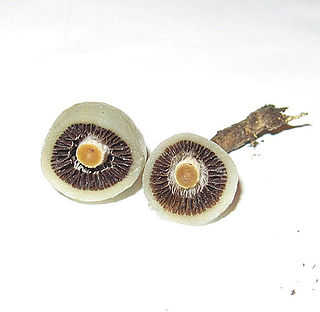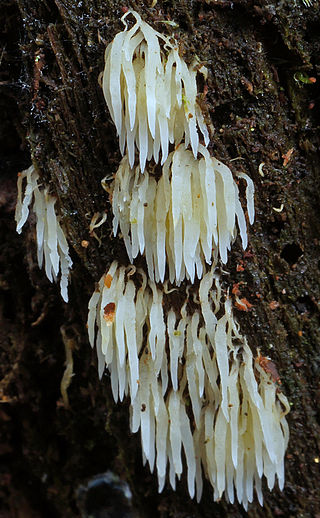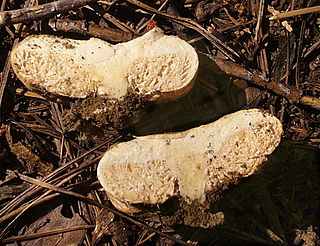Related Research Articles

Gymnopilus purpuratus is a species of agaric fungus in the family Hymenogastraceae. It grows in clusters on dead wood, tree stumps and wood chip mulch. It is widely distributed and has been recorded in Argentina, Australia, Chile, New Zealand, the UK and Germany. It has a broadly convex cap covered in small dry reddish-brown scales, a stout yellow stem beneath reddish brown, wine-red to purple vertical fibres, and a thick rusty orange spore print.

Weraroa was a genus of mushrooms from the families Hymenogastraceae and Strophariaceae. The genus was initially described by mycologist Rolf Singer in 1958 to accommodate the single species Secotium novae-zelandiae reported by Gordon Herriott Cunningham in 1924. It was thought that the genus represented an intermediary evolutionary stage between a hypogeous (underground) ancestor and the related epigeous genus Stropharia. Advances in phylogenetics and taxonomic changes since 1958 found it contained unrelated species from multiple genera. It is now considered a synonym of the genus Psilocybe.

Stamnaria is a genus of fungi in the family Helotiaceae. The genus contains at least 7 species, all of which are parasites of horsetails, reproducing through apothecia which burst through the outer surface of the hosts. It has an anamorph with genus name Titaeospora, but according to current rules the holomorph name Stamnaria should be used where possible.
Trabutia is a genus of fungi in the family Phyllachoraceae.
Kalmusia is a genus of fungi in the family Didymosphaeriaceae. The genus was formerly placed in family Montagnulaceae, before that was dissolved. The widespread, genus was estimated to contain about 12 species in 2008, which has increased to 29 species in 2023.
Broomella is a genus of fungi in the family Sporocadaceae.
Phaeothyriolum is a genus of fungi in the Microthyriaceae family.
Aulographina is a genus of fungi. It was placed in the Asterinaceae family. then later placed in the Teratosphaeriaceae family.

Pisolithus is a genus of fungi within the family Sclerodermataceae.

Disciseda is a genus of gasteroid fungi in the family Agaricaceae. It is a widely distributed genus that is prevalent in arid zones. Disciseda was circumscribed by mycologist Vassiliĭ Matveievitch Czernajew in 1845.

Mucronella is a genus of fungi in the family Clavariaceae. Species in the genus resemble awl-shaped teeth that grow in groups without a common subiculum.

Bulgaria is a genus of fungi in the family Phacidiaceae. The genus was circumscribed in 1822 by Elias Magnus Fries, with Bulgaria inquinans assigned as the type species.

Arcangeliella is a genus of gasteroid fungi in the family Russulaceae. Taxonomic and phylogenetic research has shown that it is very likely a synonym of Lactarius. The type species Arcangeliella borziana was moved to Lactarius in 2003. However, the genus name is still in use for several species for which new combinations have not yet been proposed.
Tylopilus funerarius is a bolete fungus in the family Boletaceae. Found in Singapore, it was described as new to science in 1909 by English mycologist George Edward Massee. He described it as a "sombre, uninviting species, characterised by brownish-black velvety pileus and brown tube and pores", and considered it similar in appearance to Boletus chrysenteron. The species was transferred to the genus Tylopilus in 1981.

Calostoma fuscum is a species of gasteroid fungus in the family Sclerodermataceae. Found in Australia, where it grows mainly in Eucalyptus forests, it was originally described by Miles Joseph Berkeley in 1839 as Mitremyces fuscus. George Edward Massee transferred it to the genus Calostoma in 1888.

Hypholoma brunneum is a species of mushroom in the family Strophariaceae. It was originally described in 1899 by George Edward Massee as Flammula brunnea. Derek Reid transferred it to the genus Hypholoma in 1954.
Cerocorticium molle is a species of crust fungus in the family Meruliaceae.
Eurotium is a genus of fungi belonging to the family Aspergillaceae.

Tympanella galanthina, or cottonbud pouch, is a secotioid fungus in the monotypic genus Tympanella, a member of the Bolbitiaceae family. It is endemic to New Zealand.
References
- ↑ "Protoglossum Massee 1891". MycoBank. International Mycological Association. Retrieved 2011-03-24.
- ↑ Kirk PM, Cannon PF, Minter DW, Stalpers JA (2008). Dictionary of the Fungi (10th ed.). Wallingford, UK: CABI. p. 563. ISBN 978-0-85199-826-8.
- ↑ Massee GE. (1891). "New or imperfectly known Gasteromycetes". Grevillea. 19 (92): 94–98.
- ↑ "Species Fungorum - Protoglossum". www.speciesfungorum.org. Retrieved 2023-01-11.